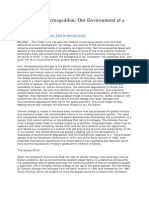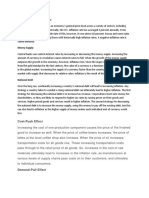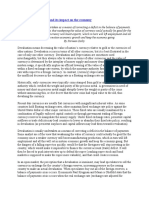Causes of Inflation
Causes of Inflation
Uploaded by
Shawn Faisal AhmedCopyright:
Available Formats
Causes of Inflation
Causes of Inflation
Uploaded by
Shawn Faisal AhmedCopyright
Available Formats
Share this document
Did you find this document useful?
Is this content inappropriate?
Copyright:
Available Formats
Causes of Inflation
Causes of Inflation
Uploaded by
Shawn Faisal AhmedCopyright:
Available Formats
Exploring the causes of inflation in Bangladesh
ECONOMISTS, policy makers and multilateral capital donors have different explanations about the causes of inflation in countries like Bangladesh. A brief look at a few of such explanations merits attention for shaping and re-shaping of appropriate policies to help curb inflation. Here below is a brief critical overview of such explanations. One of the causes of inflation, explained as such, relates to food prices in the international market. Bangladesh being a food importing country, any rise in food prices in the world market can push up the domestic prices of those commodities. In the not too distant past, the prices of essential commodities, like rice, wheat and edible oil, increased significantly in the international markets. So, domestic prices of those items shot up phenomenally then. Then the link between rising prosperity and inflation is sought to be proved by many. Despite all its problems, Bangladesh has been performing well, in terms of economic growth over the last 10 years. Its gross domestic product (GDP) base is not small, in absolute volume terms. It is the 50th largest economy in a sample of 177 countries. Not many developing countries have grown faster than Bangladesh with bigger GDP volumes since the early 1990s. Those who seek to link inflation and GDP growth performance state that the high growth rate of GDP and the per capita GDP in particular has led to the creation of excess demand in the Bangladesh economy. This has resulted in a demand-pull inflation. Then there is the growth of money supply that is directly related to the price situation. 'Inflation is a monetary phenomenon', so is explained by a good number of economists as well as some of the donor agencies. It is, thus, stated to be caused by the excessive supply of money in the economy. Bangladesh Bank has otherwise been found to be guided by the monetarist approach to inflation -and that is not without some good reason. If has been following a rather "cautious" monetary policy. Many consider it as a pragmatic step. Then the question of relative strength of Bangladesh currency in relation to those of other countries, particularly that of neighbouring India, is considered an issue of consequence for analysing the price situation here. The Bangladeshi taka has depreciated to some extent against its intervention currency, US dollar over the past several years. But the Indian rupee has depreciated higher than that. As a result, the relative position of the Bangladesh currency has suffered, having its impact on the economy because India is Bangladesh's major source of import, through both formal and informal channels. Imports from India in recent years constitute more than 20 per cent of Bangladesh's total imports, comprising many essential food items. If the import cost for Bangladesh is affected by the cross-currency exchange rates, this affects the prices. Any movement of prices in the upward direction indicates depreciation of taka relative to the currency in question after adjusting for inflation. This hypothesis does also provide some reasonably plausible explanation to the movements of prices of essential food items in Bangladesh. However, there are some disagreements among the economists and policymakers with regard to combating this situation. The policy of foreign reserve accumulation by the Bangladesh Bank is considered by some quarters as not being consistent with the exchange rate movements of taka vis-a-vis the Indian rupee in recent years. Fuel prices is yet another factor that is cited to have a major impact on the domestic price situation. If the fuel prices go up, that impacts the prices of commodities through two major channels: the high prices of fuels lead to high cost for irrigation, which raises the cost of agricultural production; and, high fuel prices increase the cost of transportation, which also raises the prices of essential items
transported from remote villages to urban areas. The non-competitive market features -- or what are stated to be "the syndicate" syndrome -- are otherwise widely considered as being one of the strong factors, igniting price pressures. Here, argument is made about many middle-men, wholesalers and importers acting as syndicates and causing large price hikes, by making cartels and hoarding essential goods like rice, wheat and edible oil. Such cartels do reportedly fix the prices of these goods, dictate supply in the market, and earn excess profits. However, there is yet no convincing, concrete evidence of 'syndicates' being in total control of the markets of essential commodities to take advantage of the weak consumer protection laws. However, some short-term alliances among the suppliers of such goods is not to be rule out to have some influence over supply and prices. This may have some impact on the rising prices of essential items. Then the issue of growth of remittances and its links with inflation come. There has been a steady and substantial rise in remittance inflow over the last few years. Such inflow does, no doubt, contribute to demand-pull inflation in Bangladesh. Working as the Rising Prosperity Hypothesis, such demand-pull factors can push up prices. But increased remittance inflow alone is unlikely to be a major cause of inflation. This is so because the rise in demand has been supported by the rise in supply through increased imports. There are many other factors behind the rising trend of inflation in Bangladesh. Such factors contribute, in their own way, to the price-hike of essential items. A detailed analysis of the situation is, thus, called for, in order to help devise a strategy for combating inflation effectively.
Inflation andBangladesh The current up trend of inflation rate is not good for Bangladeshs economy, which is already roaming with luxury double digit. This is no way a good sign or indicator for economic progress, which the Government is aspiring. This must be stopped what is called the crazy horseof inflation, which eating up of peoples savings, home, food and future. We are already in doubt whether the projected Gross Domestic Product will be achieved in the fiscal year 2011-12, subject to the following conditions are met positively If Bangladesh could indeed bring about positive fruits from itsexport of garments to India, which recently agreed upon between the two countries in a signed protocol; If the foreign remittance flow pour in regularly and satisfactorily; If infrastructural development is done as per plan; If utility services, like power, gas and energy could be ensured adequately; If proper investment from abroad, and local entrepreneurs could be achieved. In both the demand and supply are under pressure due to unprecedented rate of inflation in recent year, particularly in the period of this government. On top of this phenomena the fear and speculation of inflationary rise due to wrong government measures or economic mismanagement and indiscipline inflation is inflamed. In this September 2011 inflation rate stood at 12%, which is 9.41% in India. Reasons behind this inflation are as follows: Price hike in international commodity market, which incited the domestic market; Price rise of fuel oil also contributed to the commodity inflation in the domestic market;
Weak monetary policy also increased money supply in the market; Counterfeit money is also contributing as a dormant factor; Government borrowing from private banks, approximately Tk. 10,00,00,000/- everyday and spending it to non-productive sector, mostly by paying government recurring or revenue expenditure, e.g., salary and maintenance of government offices and institutions; Military expenditure; Private banks losing its fixed deposits as the clients are withdrawing its fixed deposits to support the rising cost, so, liquidity is squeezing; The reason for clients withdrawal is partly related to www.Unipay2you.com and www.speakasiaonlinesurvey.com who cheated people with billions of Taka, for which Government could not deny its responsibility, more pathetic is some corrupt government officials also involved with this scams and got benefited. As people lost their regular hard earned resources, last resource is the future insurance fixed or term deposits which they keep for future. In the last two years public consumption rate increased by 8%, which is 2% higher than the 2006-2007. This indicates the pressure on price levels due to level of demand factors. Importing commodities from abroad, which was 40%, covered the deficiency between theGross Domestic Product and public demands. This contributed much in affecting the noncommodity inflations. To control this high inflation rate the following steps could be followed: Controlling of money supply and printing; In the last two years supply flow was much higher than usual; Private banks must control their loans; Government borrowing from commercial banks; Bangladesh should follow China and India in monetary policy strategy, which revised interest rates 12 times in the last 18 months; Bank of China revised two types of loan interests nine times. So, Bangladesh Government must pursue drastic measures in controlling the inflation rate in order to have its budgetary goals and economic growth rate 8%. If it goes on like what is now, the government would never be able to achieve its goal of binding the inflation rate at 7.5%. If inflation could not been bottled up, the country would be in deep trouble, not the political leaders, as they have dual passports and links abroad to fly leaving the people in distress.
You might also like
- AP Macroeconomics - Unit 8 - 8.1 Final Exam QuestionsDocument19 pagesAP Macroeconomics - Unit 8 - 8.1 Final Exam QuestionsJame Chan33% (6)
- CFA Level I FormulaSheetDocument12 pagesCFA Level I FormulaSheetthomas94joseph100% (3)
- The Discounting PrincipleDocument2 pagesThe Discounting PrinciplesommelierNo ratings yet
- Facing Down Armageddon: Our Environment at A CrossroadsDocument8 pagesFacing Down Armageddon: Our Environment at A CrossroadsQuibus_LicetNo ratings yet
- What Factors Determine and Intervene in Foreign Exchange Rates - EditedDocument11 pagesWhat Factors Determine and Intervene in Foreign Exchange Rates - EditedDavid JumaNo ratings yet
- Asymmetric Information & Market FailureDocument8 pagesAsymmetric Information & Market FailureNana Chan100% (1)
- Theories of Economic Growth ReportDocument5 pagesTheories of Economic Growth ReportAubry BautistaNo ratings yet
- Expansionary and Contractionary Monetary PolicyDocument2 pagesExpansionary and Contractionary Monetary PolicyTinotenda DubeNo ratings yet
- Theory of X and yDocument6 pagesTheory of X and ybitsat hailuNo ratings yet
- Washington ConsensusDocument17 pagesWashington ConsensusJuanMartinPiaggioNo ratings yet
- Economics General Price LevelDocument15 pagesEconomics General Price LevelNeelam FartyalNo ratings yet
- 2023 - T - The Relationship Between Public Debt, Trade Openness, and Economic Growth in Indonesia Symmetric and Asymmetric AnalysisDocument26 pages2023 - T - The Relationship Between Public Debt, Trade Openness, and Economic Growth in Indonesia Symmetric and Asymmetric AnalysisNermeenNo ratings yet
- Devlopment and DependencyDocument7 pagesDevlopment and Dependencygangadhar119No ratings yet
- Fiscal PolicyDocument16 pagesFiscal PolicyMar DacNo ratings yet
- Fiscal Policy NotesDocument5 pagesFiscal Policy NotesJaydenausNo ratings yet
- Keynesian Theory of Employment With DiagramDocument7 pagesKeynesian Theory of Employment With DiagramSuZan TimilsinaNo ratings yet
- Welfare StateDocument3 pagesWelfare StateJahan Choudhury100% (1)
- GDP and WelfareDocument23 pagesGDP and WelfareAshish SinghNo ratings yet
- Devaluation of Chinese YuanDocument4 pagesDevaluation of Chinese Yuanvijendra1125No ratings yet
- The Impact of Monetary Policy On Economic Growth and Price Stability in Kenya: 1992-2013Document15 pagesThe Impact of Monetary Policy On Economic Growth and Price Stability in Kenya: 1992-2013IOSRjournal0% (1)
- FULLTEXT01Document39 pagesFULLTEXT01woldiainspectionNo ratings yet
- Assignment - Chapter 6 (Strategies For Economic Development)Document5 pagesAssignment - Chapter 6 (Strategies For Economic Development)akshaylt25100% (1)
- Real Business Cycle TheoryDocument32 pagesReal Business Cycle Theoryrajan20202000No ratings yet
- Realism Essay PDFDocument12 pagesRealism Essay PDFHamsey45No ratings yet
- Chapter 01Document82 pagesChapter 01S. Shanmugasundaram100% (1)
- Factors Affecting Inflation RateDocument14 pagesFactors Affecting Inflation RateMarielle CatiisNo ratings yet
- Tariff and Non Tariff BarriersDocument9 pagesTariff and Non Tariff Barrierscharlotte frances bagaoisan100% (1)
- 1.3 Government Intervention 1ewj1inDocument28 pages1.3 Government Intervention 1ewj1inShatabdiDasNo ratings yet
- Measurement of Economic DevelopmentDocument10 pagesMeasurement of Economic DevelopmentFaisal ShafiqueNo ratings yet
- RecessionDocument62 pagesRecessionVandana Insan100% (1)
- Executive Summary: The Global OutlookDocument34 pagesExecutive Summary: The Global OutlookmarrykhiNo ratings yet
- Notes On Tariff, Import Quota and NTB'sDocument13 pagesNotes On Tariff, Import Quota and NTB'sdivyaNo ratings yet
- Currency Devaluation and Its Impact On The EconomyDocument4 pagesCurrency Devaluation and Its Impact On The Economytalha_ahmedNo ratings yet
- Global GovernanceDocument14 pagesGlobal GovernanceVinch Michael Aguilos100% (1)
- Measuring Domestic Output, National Income and The Price LevelDocument50 pagesMeasuring Domestic Output, National Income and The Price LevelWei TattNo ratings yet
- Resources and Trade: The Heckscher-Ohlin Model: © Pearson Education Limited 2015Document104 pagesResources and Trade: The Heckscher-Ohlin Model: © Pearson Education Limited 2015Emre PakNo ratings yet
- Dependency Theory How Relevant Is It Today-AJSen-08Document13 pagesDependency Theory How Relevant Is It Today-AJSen-08ANshutosh Sharma100% (1)
- Keynes Law of ConsumptionDocument7 pagesKeynes Law of ConsumptionMohammedAhmedRazaNo ratings yet
- Command & Market EconomyDocument1 pageCommand & Market EconomyAbid KhanNo ratings yet
- Cost Push InflationDocument2 pagesCost Push InflationManoj KNo ratings yet
- BMS Economics PPT Section 2Document21 pagesBMS Economics PPT Section 2rajan2778No ratings yet
- Vincent Ferraro - Dependency TheoryDocument8 pagesVincent Ferraro - Dependency TheoryTolessaNo ratings yet
- Industrialization in IndiaDocument19 pagesIndustrialization in IndiaPhxx61967% (3)
- Inflation in Pakistan: Psychology AssignmentDocument9 pagesInflation in Pakistan: Psychology AssignmentSyed MohtashimNo ratings yet
- Law of Diminishing Marginal ReturnsDocument1 pageLaw of Diminishing Marginal ReturnsNirmalNo ratings yet
- Analyzing Paper 1 - SLDocument8 pagesAnalyzing Paper 1 - SLSushanta BaruaNo ratings yet
- 3.term PaperDocument14 pages3.term Paperrohitpatil999100% (4)
- Practice Problems 1Document4 pagesPractice Problems 1Vaibhav VermaNo ratings yet
- What Is GlobalizationDocument9 pagesWhat Is GlobalizationStephanie Dawn CachuelaNo ratings yet
- Fiscal Policy: Submitted byDocument17 pagesFiscal Policy: Submitted byJadedGothNo ratings yet
- BiologyDocument8 pagesBiologyraajeevms100% (1)
- History of Economic Thought Lecture2 (UN 1)Document27 pagesHistory of Economic Thought Lecture2 (UN 1)Chewaka Temena100% (1)
- Chapter-One Overview of Public Finance & TaxationDocument211 pagesChapter-One Overview of Public Finance & Taxationarsen lupinNo ratings yet
- Adam Smith's TheoryDocument16 pagesAdam Smith's TheorySneha AgrawalNo ratings yet
- Unit-14 Deficit Financing PDFDocument12 pagesUnit-14 Deficit Financing PDFSatish DasNo ratings yet
- Schumpeter Theory of Economic DevelopmentDocument26 pagesSchumpeter Theory of Economic DevelopmentHaseena AnwarNo ratings yet
- Greek Fiscal Crisis: Is A First World Debt Crisis in The Making?Document32 pagesGreek Fiscal Crisis: Is A First World Debt Crisis in The Making?Babasab Patil (Karrisatte)No ratings yet
- Inflation Causes and Effects RevisionDocument26 pagesInflation Causes and Effects RevisionData AnalystNo ratings yet
- Dornbusch MacroeconomicDocument31 pagesDornbusch Macroeconomicshalini4071979No ratings yet
- Burden of Public DebtDocument4 pagesBurden of Public DebtAmrit KaurNo ratings yet
- Poverty in the United States: Why It's a Blight On the American PsycheFrom EverandPoverty in the United States: Why It's a Blight On the American PsycheNo ratings yet
- Money Demand, The Equilibrium Interest Rate, and Monetary PolicyDocument30 pagesMoney Demand, The Equilibrium Interest Rate, and Monetary Policyhasan jabrNo ratings yet
- Solution Manual For Financial Markets AnDocument12 pagesSolution Manual For Financial Markets AnNadiya Iftekhar100% (1)
- New Central Bank ActDocument12 pagesNew Central Bank ActLouisPNo ratings yet
- Submitted To: Mr. Rashid Saeed Submitted By: Sundas Tauqeer BBAML-16-18 Bba 7 (Morning)Document23 pagesSubmitted To: Mr. Rashid Saeed Submitted By: Sundas Tauqeer BBAML-16-18 Bba 7 (Morning)ZIA UL REHMANNo ratings yet
- CSC Practice QS PDFDocument304 pagesCSC Practice QS PDFDavid Young0% (1)
- Economic Effects of Panama'S Offshore Banking Sector: A. IntroductionDocument7 pagesEconomic Effects of Panama'S Offshore Banking Sector: A. IntroductionNathirah rosleeNo ratings yet
- Nippon India Balanced Advantage FundDocument85 pagesNippon India Balanced Advantage FundKeval ShahNo ratings yet
- Monetary Policies of RBIDocument27 pagesMonetary Policies of RBIrudraarjunNo ratings yet
- EportfolioexcelDocument4 pagesEportfolioexcelapi-311464761No ratings yet
- Bloomberg Businessweek USA - January 15-March 24 2024Document88 pagesBloomberg Businessweek USA - January 15-March 24 2024nguyen trungNo ratings yet
- 2022 2024 Mtef FSP Final 07072021Document68 pages2022 2024 Mtef FSP Final 07072021mayorladNo ratings yet
- The Four Basic Truths of MacroeconomicsDocument4 pagesThe Four Basic Truths of Macroeconomicsrehhann77No ratings yet
- 3RD Term SS1 Economics Note For StudentsDocument25 pages3RD Term SS1 Economics Note For Studentsinyamahchinonso100% (1)
- Financial Crisis and Challenges For The FutureDocument16 pagesFinancial Crisis and Challenges For The FutureMaizatunisak Muhamad SaadNo ratings yet
- CTM 201301Document29 pagesCTM 201301ist00% (1)
- Journal of International Money and Finance: Oana Peia, Davide RomelliDocument19 pagesJournal of International Money and Finance: Oana Peia, Davide RomelliMadiha MunirNo ratings yet
- Floating Exchange RateDocument2 pagesFloating Exchange RateMuhammad FaizanNo ratings yet
- Pestel: What Is PESTEL Analysis?Document7 pagesPestel: What Is PESTEL Analysis?Sherwin Basan CelestialNo ratings yet
- Payment System Issues and ChallengesDocument14 pagesPayment System Issues and Challengesray_alokNo ratings yet
- 2014-2015 Kumari Bank Annual ReportDocument104 pages2014-2015 Kumari Bank Annual Reportdevi ghimireNo ratings yet
- Chapter 11 Dornbusch Fisher SolutionsDocument13 pagesChapter 11 Dornbusch Fisher Solutions22ech040No ratings yet
- Final Review HandoutDocument18 pagesFinal Review HandoutLiah Piano-Beast UchihaNo ratings yet
- Economics of Pakistan Guess Papers 2015 BDocument6 pagesEconomics of Pakistan Guess Papers 2015 Bsufyanbutt007No ratings yet
- IAS Economics - Aggregate Demand (AD)Document8 pagesIAS Economics - Aggregate Demand (AD)Jonathan JeevaratnamNo ratings yet
- Poon Wai ChingDocument15 pagesPoon Wai ChingRyan Yu SyuenNo ratings yet
- 13 03 2019 BScinAccounting2013Document17 pages13 03 2019 BScinAccounting2013Ali HasanNo ratings yet
- Contributions of Fidel VDocument11 pagesContributions of Fidel VArdee Marius GuzmanNo ratings yet
- Rational ExpectationsDocument13 pagesRational ExpectationsAminu Abubakar HassanNo ratings yet

























































































